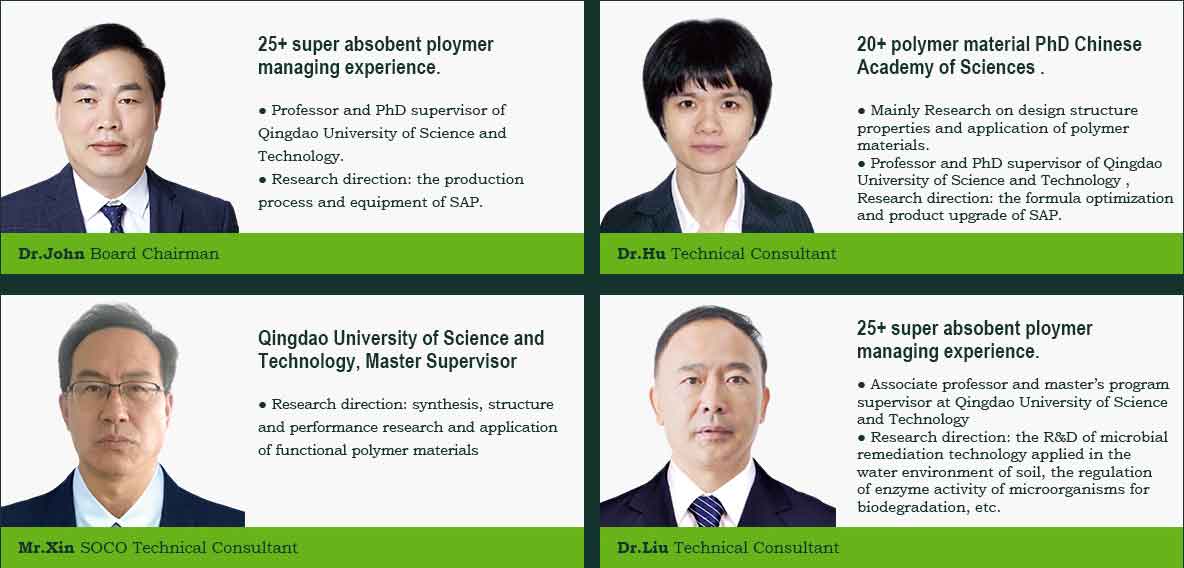As the largest rice crop in China, with the highest yield and total output, its perennial cultivation area and total output account for about 28% and 40% of China's grain crops.
Rice production is related to national food security, agricultural efficiency and farmers' income [1
-2
The mechanization of rice production is an inevitable trend in the future development of rice. According to statistics, in 2012, China's rice machinery planting area accounted for 26.24% of the total rice area.
According to statistics, in 2012, the area of rice mechanized planting in China accounted for 26.24% of the total area of rice [3]. The key to the mechanization of rice planting is machine transplanting, which is very different from conventional transplanting.
The key to mechanization of rice planting is machine transplanting. Therefore, to cultivate strong seedlings suitable for machine transplanting and improve the quality of planting is the key to the development of machine transplanting technology [4].
The key to the development of machine transplanting technology is therefore to cultivate strong seedlings suitable for machine transplanting and improve the quality of planting [4
-5].
In this experiment, we used the nutrient soil fertilization of field mud as the substrate for planting rice seedlings in machine transplanting trays, and designed different doses of water retention agent potassium polyacrylate to cultivate rice machine transplants.
In this experiment, we used the nutrient soil fertilizer of field mud as a substrate for planting rice seedlings.
This study was carried out to provide data for the application of rice transplanting seedlings and the development and application of seedling substrate.
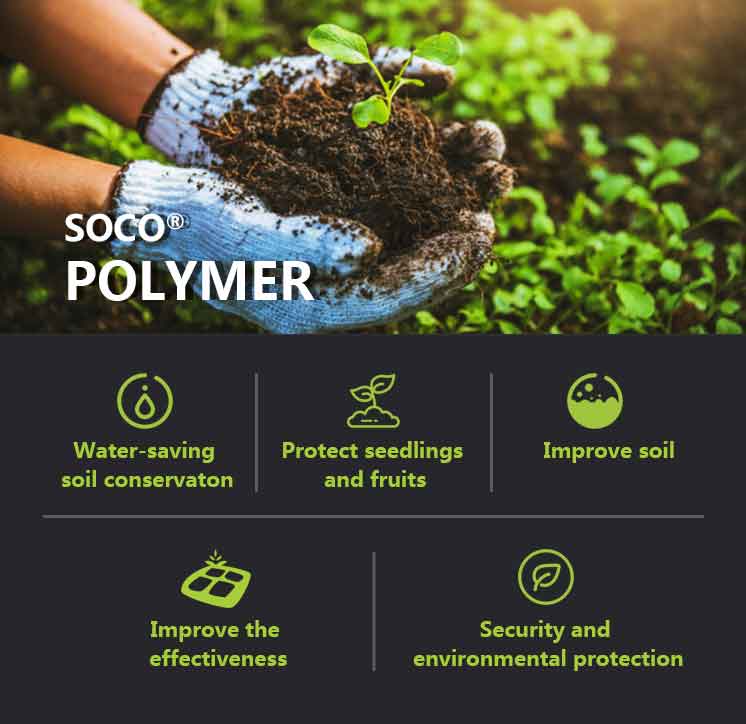
1. Materials and methods
1.1 Experimental materials
The experimental rice variety was the three-line single-season hybrid rice Guoyao 7 (provided by China Rice Research Institute). The seedling tray was made of hard plastic tray with the specification of 58cm×28cm.
The size of the tray is 58cm×28cm, and the seed sowing volume is 50g/tray.
1.2 Experimental treatment
The nutrient soil fertilization of field mud was used as the substrate of machine seedling trays, and each tray was calculated according to 3 kg of air-dried nutrient soil, with 50 g of organic fertilizer per tray and 0.8 g of trimsulfuron.
Each tray was used with organic fertilizer of 50g and trimsulfuron 0.8g and buthiocarb 1.2g for pest and disease control. In the experiment, each tray of nutrient soil (3 kg) was evenly mixed with 5, 10 and 20 g of different amounts of potassium polyacrylate.
The experiment was conducted with 5, 10 and 20 g of
potassium polyacrylate per tray of nutrient soil (3 kg), and the conventional seedlings were used as the control (CK). Rice seeds were soaked with imipramine for 48 h at room temperature and germinated for 24 h at 35 ℃ in a germination box (SZC-32 type) before sowing. After sowing
After sowing, the seedling trays were placed in the growing room cultivation pool for seedling cultivation, and no other nutrients were applied during the seedling cultivation period, and the water management was based on the dry seedling cultivation method [6]. Seedling
During seedling cultivation, natural light was used and the temperature was set at 14h30 ℃ (daytime) and 10h25 ℃ (evening). When the seedlings grew to 3 leaves and 1 heart
The rice plant samples were taken to determine the indexes.
1.3 Indexes and measurement methods
Take a random sample of 20 rice seedlings, examine the plant height, root length and number of roots, record and take the average value. The rice plant was divided into two parts: above ground and root system.
The rice plant was washed with distilled water, dried to constant weight at 85 ℃, and then weighed the dry matter mass. The relative water content of the leaves was determined by the method of Guo Longbiao et al [7], and the chlorophyll content of the leaves was determined by acetone extraction.
The relative water content of leaves was determined by the method of Guo Longbiao et al [7], the chlorophyll content of leaves was determined by acetone extraction [8], the soluble sugar content of leaves was determined by the anthranilic acid method [9], and the root activity was determined by the α
-naphthylamine oxidation method [10] was used for the determination of leaf chlorophyll content.
The root system activity was determined by α-naphthylamine oxygenation method [10].
2. Results and analysis
As shown in Table 1, with the increase of water retention agent potassium polyacrylate, the plant height showed an increasing trend, i.e., the plant height of 20g/plate of potassium polyacrylate was higher than that of 5g/plate and 10g/plate.
The plant height of 20g/plate of potassium polyacrylate was higher than that of 5g/plate and 10g/plate. The maximum root length was 7.35 cm for the seedlings treated with 10 g/pan of potassium polyacrylate, followed by 7.06 cm for the seedlings treated with 5 g/pan.
The maximum root length was 7.35 cm for the 10 g/plate of potassium polyacrylate treatment, followed by 7.06 cm for the 5 g/plate treatment, and 6.63 cm for the 20 g/plate treatment, which was not much different from that of the control. In terms of root traits, the highest number of roots was found in the 5g/tray treatment, with an average of 10.5 cm.
In terms of root traits, the highest number of roots was found in the seedlings of the 5g/tray treatment, with an average of 10.38 roots, followed by 9.95 roots in the control, and the lowest number of roots was found in the seedlings of the 20g/tray treatment, with 6.55 roots. Seedling
The maximum dry matter accumulation of seedlings was 0.04g for 5g/tray and 10g/tray, and 0.03g for both control and 20g/tray.
The maximum accumulation of fresh matter in seedlings was 0.19g for 10g/plate, 0.18g for 20g/plate, and 0.17g for both control and 5g/plate treatments.
The quality of the seedlings raised in the tray with 10g/tray is higher than that of the seedlings in the other treatments.
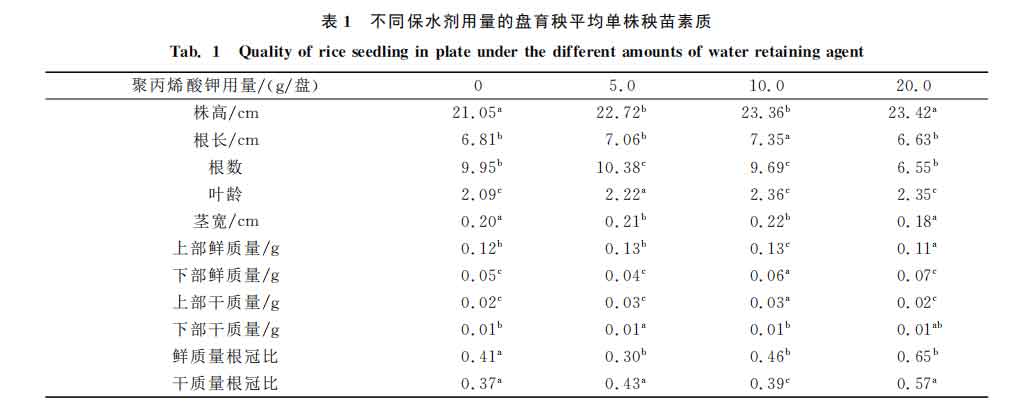
2.2 Relative water content of rice leaves with different potassium polyacrylate dosages
Figure 1 shows the changes of relative water content of rice seedlings at the 3-leaf-1 stage under different potassium polyacrylate dosages. It can be seen that the relative water content of rice seedlings at 20g/plate is the highest, followed by the relative water content of rice seedlings at 3 leaves and 1 heart.
The relative water content of rice leaves at the 3-leaf-1 stage of rice seedlings was highest at 20g/pan, followed by 10g/pan and lowest at 5g/pan.
The relative water content of rice leaves was higher than that of the control. The relative water content of rice seedling leaves increased with the addition of the water retention agent potassium polyacrylate in the range of potassium polyacrylate dosages tested.
The higher the amount of potassium polyacrylate added, the higher the relative water content of the leaves.
2.3 Chlorophyll content of rice leaves with different amounts of potassium polyacrylate
As shown in Figure 2, the chlorophyll content of rice seedling leaves decreased with the increase of potassium polyacrylate in the range of potassium polyacrylate dosage designed for the experiment.
The chlorophyll content of rice seedlings gradually decreased with the increase of potassium polyacrylate. The chlorophyll content of 5, 10 and 20 g/pan rice seedlings contained 2.93, 2.87 and 2.71 mg/g of chlorophyll, respectively, which were 12.8%, 14.8% and 14% lower than that of the control.
Compared with the control, the chlorophyll content of 5, 10 and 20 g/plate seedlings decreased by 12.8%, 14.6% and 19.1%, respectively. In addition, the chlorophyll content of rice leaves differed between 5 and 10 g of potassium polyacrylate.
The chlorophyll content of the control was the highest.
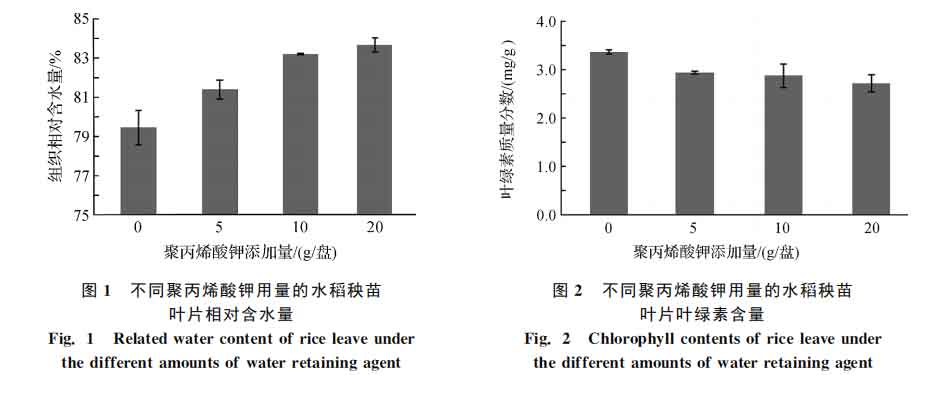
2.4 Soluble sugar content of rice leaves with different potassium polyacrylate dosages
From Fig. 3, it can be seen that the soluble sugar content of rice seedling leaves showed a decreasing trend with the increase of potassium polyacrylate dosage in the range of the experimental potassium polyacrylate dosage.
The soluble sugar content of rice seedlings showed a decreasing trend with the increase of potassium polyacrylate. The control leaves contained the highest amount of soluble sugar, 0.66ug/g, and the leaves with 20g/pan of potassium polyacrylate contained the lowest amount of soluble sugar, 0.6ug/g.
At the same time, as the amount of potassium polyacrylate increased from 5g/disc to 10 and 20g/disc, the soluble sugar content of the leaves decreased significantly less than that of 5g/disc.
The decrease in soluble sugar content was significantly lower than that between the 5g/plate of potassium polyacrylate treatment and the control.
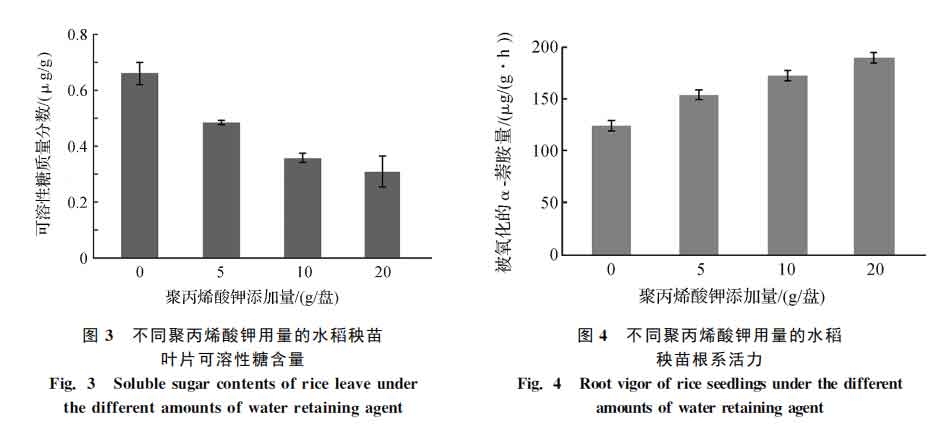
2.5 Root vigor of rice with different potassium polyacrylate dosages
Figure 4 reflects the effect of adding different amounts of potassium polyacrylate to the nutrient soil on the root vigor of rice seedlings. The root vigor of rice seedlings treated with potassium polyacrylate
The root vigor of rice seedlings treated with potassium polyacrylate increased compared with the control 124.5ug/(g-h) and showed a gradual increase, with 153.9, 172.4 and 189.3ug/(g-h) respectively.
The increases were 23.6%, 38.5% and 52.0%, respectively. This indicates that the higher the amount of potassium polyacrylate added in the experimental range, the higher the root vigor of rice.
The more potassium polyacrylate was added, the stronger the root vigor of rice.
3. Discussion
The three most significant characteristics of rice seedling cultivation are: high seeding density (75-200g/tray of dry rice grain, 25g/thousand grain weight of rice grain), 3000 seeds per tray.
The three most significant characteristics of rice machine seedling cultivation are: high sowing density (dry rice grain is 75-200g/tray, and each tray has 3000-8000 rice seeds based on a thousand grain weight of 25g), limited space for seedling root growth (tray size is 58cm×28cm×3cm), and long age of seedlings (15-35d).
The root growth space of rice seedlings is limited (the size of the seedling tray is 58cm×28cm×3cm) and the age of rice seedlings is long (15-35d). The plant injury to rice seedlings in the rice tray by machine insertion is more serious, especially the root damage, resulting in slow growth after machine insertion, which affects the growth and development of rice seedlings [11].
seedling growth and development [11-13]. In production, growth regulators, nutrient and water management techniques and measures are mostly used to cultivate healthy seedlings. However
However, practice has shown that fertilizer and water management is very tedious if implemented according to the requirements of rice seedling growth and development, which is a limiting factor for rice planting in trays.
23
2016 Sub [14-16]. Studies have shown that the proper application of water retention agents can promote crop root development, and the damage to the root system of machine-planted seedlings is greater, and the proper application of water retention agents
It can improve the seedling emergence rate and transplanting survival rate, promote plant growth and development, and enable rice to return to green in the shortest possible time and delay the withering time [17 -18].
-18].
In this paper, we conducted a trial of adding different amounts of potassium polyacrylate to the nutrient soil of rice tray seedlings, and the results showed that potassium polyacrylate had a significant effect on the quality of rice tray seedlings.
The results of the study showed that potassium polyacrylate had a significant effect on the quality of rice seedlings raised in trays. Compared with the control, seedling height, stem base width, root number, root length, above-ground and below-ground dry mass, which reflect the quality of seedlings, increased significantly.
The amount of potassium polyacrylate added at 10g/pan was the best. In terms of physiological traits, the relative water content of leaves of rice seedlings with potassium polyacrylate added to the nutrient soil increased significantly.
In terms of physiological properties, the relative water content of leaves and root vigor of rice seedlings with potassium polyacrylate added to the nutrient soil increased, reflecting that the use of potassium polyacrylate could promote the physiological activity of the seedlings in tray culture and obtain healthy seedlings.
This reflects that the use of potassium polyacrylate can promote the physiological activity of tray seedlings and obtain healthy seedlings. At the same time, the experimental data showed that the chlorophyll and soluble sugar contents of the leaves gradually decreased with the increase of potassium polyacrylate.
It is assumed that the addition of potassium polyacrylate to the nutrient soil promoted the conversion of photosynthetic products-soluble sugar in rice seedlings, which was not only reflected in the improvement of seedling quality, but also in the increase of physiological activity.
This transformation was not only reflected in the improvement of seedling quality and physiological activity, but also in the morphology and physiological activity of the subsurface root system.
The application of potassium polyacrylate in rice cultivation and production is not well reported.
In this paper, the application of potassium polyacrylate in rice tray seedling nutrient soil was tested and combined with the characteristics of rice tray seedling with nutrient soil for machine insertion.
The quality and physiological activity of rice seedlings could be improved with the addition of potassium polyacrylate in the rice tray seedling nutrient soil at about 10g/tray.

